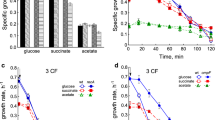Summary
To investigate the interactions of heavy metals with cells, a minimal medium for the growth of enteric bacteria using glycerol-2-phosphate as the sole phosphorus source was developed that avoided precipitation of Pb2+ with inorganic phosphate. Using this medium, spontaneous mutants ofEscherichia coli resistant to addition of Pb(NO3)2 were isolated. Thirty-five independent mutants all conferred a low level of resistance. Disk diffusion assays on solid medium were used to survey the response ofE. coli andSalmonella typhimurium mutants altered in global regulatory networks to Pb(NO3)2) and CdCl2. Strains bearing mutations inoxyR andrpoH were the most hypersensitive to these compounds. Based upon the response of strains completely devoid of isozymes needed to inactivate reactive oxygen species, this hypersensitity to lead and cadmium is attributable to alteration in superoxide dismutase rather than catalase levels. Similar analysis of chaperonedefective mutants suggests that these metals damage proteins in vivo.
Similar content being viewed by others
References
Bochner, B.R. and B.N. Ames. 1982. Complete analysis of cellular nucleotides by two-dimensional thin layer chromatography. J. Biol. Chem. 257: 9759–9769.
Carlioz, A. and D. Touati. 1986. Isolation of superoxide dismutase mutants inEscherichia coli: is superoxide dismutase necessary for aerobic life? EMBO J. 5: 623–630.
Casadaban, M.J. 1976. Transposition and fusion of thelac genes to selected promoters inEscherichia coli using bacteriophage Lambda and Mu. J. Mol. Biol. 104: 541–555.
Christman, M.F., R.W. Morgan, F.S. Jacobson and B.N. Ames. 1985. Positive control of a regulon for defenses against oxidative stress and some heat-shock proteins inSalmonella typhimurium. Cell 41: 753–762.
Craig, E.A. and C.A. Gross. 1991. Is hsp 70 the cellular thermometer? Trends Biochem. Sci. 16: 135–140.
Davis, R.W., D. Botstein and J.R. Roth. 1980. Advanced Bacterial Genetics. Cold Spring Harbor Laboratory Press, Cold Spring Harbor.
Ernsting, B.R., M.R. Atkinson, A.J. Ninfa and R.G. Matthews. 1992. Characterization of the regulon controlled by the leucineresponsive regulatory protein inEscherichia coli. J. Bacteriol. 174: 1109–1118.
Fayet, O., J.M. Louarn and C. Georgopoulos. 1986. Suppression of theEscherichia coli dnaA46 mutation by amplification of thegroES andgroEL genes. Mol. Gen. Genet 202: 435–445.
Greenberg, J.T., J.H. Chou, P.A. Monach and B. Demple. 1991. Activation of oxidative stress genes by mutations at thesoxQ/cfxB/marA locus ofEscherichia coli. J. Bacteriol. 173: 4433–4439.
Greenberg, J.T., P. Monach, J.H. Chou, P.D. Josephy and B. Demple. 1990. Positive control of a global antioxidant defense regulon activated by superoxide-generating agents inEscherichia coli. Proc. Natl. Acad. Sci. USA 87: 6181–6185.
Hartman, P.E. and D.C. Kuo. 1987. Cd2+ tolerance inEscherichia coli andSalmonella typphimurium. Environ. Mutagen 10: 89–95.
Jensen, K.F. 1993. TheEscherichia coli K-12 ‘wild type’ W3110 and MG1655 have anrph frameshift mutation that leads to pyrimidine starvation due to lowpyrE expression levels. J. Bacteriol. 175: 3401–3407.
Kusukawa, N. and T. Yura. 1988. Heat shock protein GroE ofEscherichia coli: key protective roles against thermal stress. Genes Dev. 2: 874–882.
LaRossa, R.A. and T.K. Van Dyk. 1991. Physiological roles of the DnaK and GroE stress proteins: catalysts of protein folding or macromolecular sponges? Molec. Microbiol. 5: 529–534.
Loewen, P.C. and B.L. Triggs. 1984. Genetic mapping ofkatF, a locus that withkatE affects the synthesis of a second catalase species inEscherichia coli. J. Bacteriol. 160: 668–675.
Macaskie, L.E. and A.C.R. Dean. 1982. Cadmium accumulation by microorganisms. Environ. Technol. Lett. 3 49–56.
Maloy, S.R. and W.D. Nunn. 1981. Selection for loss of tetracycline resistance byEscherichia coli. J. Bacteriol. 145: 1110–1112.
Menzel, R. 1989. A microtiter plate-based system for the semiautomated growth and assay of bacterial cells for β-galactosidase activity. Anal. Biochem. 181: 40–50.
Miller, J.H. 1972. Experiments in Molecular Genetics. Cold Spring Harbor Laboratory Press, Cold Spring Harbor.
Mulvey, M.R., P.A. Sorby, B.L. Triggs-Raine and P.C. Loewen. 1988. Cloning and physical characterization ofkatE andkatF required for catalase HPII expression inEscherichia coli. Gene 73: 337–345.
Neidhardt, F.C., P.L. Bloch and D.F. Smith. 1974. Culture medium for Enterobacteria. J. Bacteriol. 119: 736–747.
Neidhardt, F.C. and R.A. VanBogelen. 1987. Heat shock response. In:Escherichia coli andSalmonella typhimurium. Cellular and Molecular Biology (Neidhardt, F., ed.), pp. 1334–1345, F.C. American Society for Microbiology, Washington, DC.
Parsell, D.A. and S. Lindquist. 1993. The function of heat-shock proteins in stress tolerance: degradation and reactivation of damaged proteins. Annu. Rev. Genet. 27: 437–496.
VanBogelen, R.A., P.M. Kelley and F.C. Neidhardt. 1987. Differential induction of heat shock, SOS and oxidation stress regulon and accumulation of nucleotides inEscherichia coli. J. Bacteriol. 169: 26–32.
Xiao, H., M. Kalman, K. Ikehara, S. Zemel, G. Glaser and M. Cashel. 1991. Residual guanosine 3′,5′-bispyrophosphate synthetic activity ofrelA null mutants can be eliminated byspoT null mutations. J. Biol. Chem. 266: 5980–5990.
Author information
Authors and Affiliations
Rights and permissions
About this article
Cite this article
LaRossa, R.A., Smulski, D.R. & Van Dyk, T.K. Interaction of lead nitrate and cadmium chloride withEscherichia coli K-12 andSalmonella typhimurium global regulatory mutants. Journal of Industrial Microbiology 14, 252–258 (1995). https://doi.org/10.1007/BF01569936
Received:
Accepted:
Issue Date:
DOI: https://doi.org/10.1007/BF01569936




